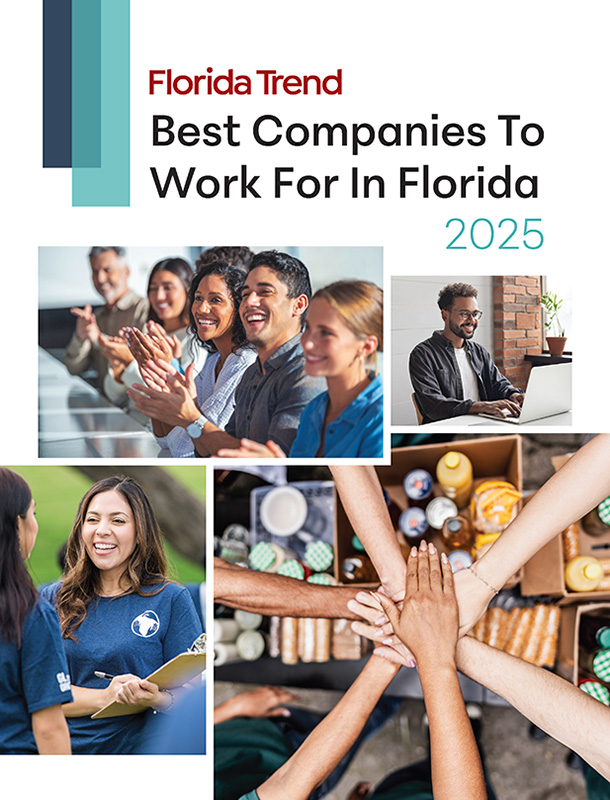April 2025 | Evan Williams
Artificial intelligence is being used to reduce costs, help diagnose life-threatening conditions and fuel medical research — including on AI itself — at Florida hospitals. The technology also poses technical and ethical challenges for providers who are navigating its fast-growing use and availability. Health care professionals across the state shared with FLORIDA TREND how they use AI, how they don’t (at least, not yet), and the benefits they’re seeing.
Ben Shahshahani
Chief AI Officer, Cleveland Clinic
AI Uses: Cleveland Clinic is using AI to accelerate the pace of medical research, enhance patient care, and address caregiver and organizational challenges. We are utilizing AI to invent tomorrow’s care through initiatives such as AI-guided brain surgery, our groundbreaking partnership with IBM to accelerate medical discovery, our work with Palantir to reimagine hospital operations, and using technologies like AI scribes to reduce the administrative burden on our caregivers.
Patient Benefits: It can align patients with the right care in a timely manner and can synthesize unstructured data from patients, resulting in better care. Examples include the use of AI in mammography and imaging for epilepsy, and in early detection of sepsis.
Challenges: The biggest challenges … include addressing concerns around security, safety and fairness. It is critical that organizations act responsibly when implementing AI. We address these challenges by having a person standing behind the output of AI applications and rigorously monitoring the quality. We also have established an AI Task Force which reviews new AI projects to ensure they are high quality, safe, equitable and responsible.
Economic Benefits: For patients, AI can provide better care delivery and align them with the right care in a timely manner. For hospitals, AI can help run business operations smarter and more efficiently and allow caregivers to spend less time entering data and more time caring for patients. This ultimately reduces the cost of health care and benefits patients.
Lynnette Clinton
Chief Information Officer, BayCare
AI in Action: BayCare uses artificial intelligence to improve accuracy of tasks like documentation and improve efficiency of our clinicians and physicians to allow more time on higher-value activities, like direct patient interaction. … BayCare uses an AI tool to help detect strokes faster. We’re trying out other tools to help physicians and nurses do their documentation so they can focus more on their patients, and we provide a conversational AI tool for our patients to be better informed on the right place to go for the care they need.
Off Limits: We have drawn the line for AI on decision-making. We will use AI to serve up information quickly, but we default to our physicians and clinicians to make the ultimate decisions for patient care.
Making Choices: There are hundreds, if not thousands, of health care vendors claiming AI in their products. The biggest challenge is to make sure to find and choose the right vendors along with the right use cases to solve the biggest problems. There are unlimited applications to spend money and time on, with limited funds and time to do it.
Time Saver: A major clinical benefit for patients is realized in the allowing of faster decisions by our physicians. As the saying goes, time is brain. An economic benefit for patients could be found in our virtual triage tool. If you enter your symptoms and the tool lets you know that you can go to an urgent care instead of the emergency department, it could save patients from paying a bigger copay and deductible. Economic benefits for health care providers come when the efficiency a tool brings outweighs the cost of the tool.
Dr. Nishit Patel
Vice President and Chief Medical Informatics Officer, Tampa General Hospital and professor, USF Health Morsani College of Medicine
Leveraging AI: One of the places where we leveraged a really amazing set of (AI) tools is the management of a life-threatening condition called sepsis, one of the leading causes of death of patients in the hospital. It’s when an infection gets out of control. It’s a difficult diagnosis because there’s no single lab test that makes it. (AI) tools allow us to, No. 1, detect somebody who might be heading towards that condition. Over roughly two years now, we reduced our mortality rate by a third. We were sitting around 10% when the national average is about 18%, and we lowered that even down to under 7%, so we’re talking about world-class performance on a life-threatening disease. As a result, we’ve had over 400 patients go home and recover from it who would otherwise not have based on that 33% improvement in mortality rate.
Challenges: People are nervous. They’re nervous that an algorithm is going to make a life-or-death decision for them; an algorithm is going to decide, you know, what happens to their loved one. That’s sort of the general angst in the community, which is very different than we think about AI in other spaces.
Every AI tool that we put in our health system goes through a significant vetting process that has not only technologists but ethicists, risk compliance (professionals), privacy officers, physicians, nursing leaders, operational leaders ... all around the table. And we debate the heck out of these products. We never want to create harm.
“At the end of the day, the buck stops with the clinician, but we’re giving the clinician a lot of the tools to be able to be that much more comprehensive, efficient and safe. ... Hopefully, if we do this well, (we can) execute the entire care spectrum a lot more efficiently for the patient.” — Dr. Nishit Patel
Economic Benefits: I think there’s tons of opportunity to make the process more efficient, to drive down costs. Some of the other things we’re talking about don’t necessarily have a hard return on investment but are still really meaningful because they are aligned with our mission as an academic medical center and a safety net hospital. As long as we’re doing the good work, you know, there’s an overall benefit.
I do think the macro forces in health care are interesting, especially for us in Tampa and in Florida. We can’t grow new nurses, new doctors, new facilities at the rate that we have population growth. So, we have to find a way to make the existing clinical workforce far more efficient and perform at a higher and higher quality. That’s normally an impossible math formula. I think AI gives us the potential to solve that in a way we’ve never been able to. So, quality goes up, costs go down, and sort of everybody wins because people are satisfied both on the care delivery side and the patient side as well. But I am an optimist, so that’s inherently how I think about the world.
Dr. Sarah McLaughlin
Chair for the Department of Surgery/Lead for Executive Operations Team on AI & Automation, Mayo Clinic Florida
AI in Action: We use AI in many ways. AI helps manage outside medical record ingestion. It helps navigate complex patient electronic charts. It aids in ambient listening of patient-physician conversations, creating a medical record document that the physician can review after the visit, which allows the physician to spend more time face-to-face with the patient in real time.
Patient Care: We use it in patient care to help engineers. provide additional detail when reviewing imaging like mammograms and chest X-rays. We use it in prediction models to anticipate and diagnose diseases at earlier stages — like using ECG data to predict and diagnose heart failure and CT scans to diagnose pancreatic cancer earlier. We use it to personalize patient care like scheduling appointments. In the future, it is likely that AI will help refine patient care pathways predicting additional needs, as well as the patient itinerary in who they need to see and when.
Risk/Benefit Analysis: AI is likely to become part of all aspects of our daily activities. However, we currently continue to balance the risk and benefit when determining use case scenarios when it comes to patient care. AI can be very helpful in decreasing the time it takes to do many office-based administrative tasks — like sorting faxes or messages.
Economic Benefits: AI, when implemented correctly, will allow all members of the care team and support teams to work at the top of their license, eliminating much of the current administrative burden.
Lana Bender
Vice President, AI and Behavioral Science, GuideWell & Florida Blue
Prior Auth: We were one of the first payers that launched (a prior authorization tool) in 2022. We use it for approvals only. … We never use it for denial, and even with approval, one of our pillars is making sure that there’s a human in the loop, so any output gets vetted by a human.
Physician Burnout: (To address physician burnout) we launched a couple of solutions for our physician partners — ambient listening as well as first draft of email generation as well. … (Doctors) have to do more and more admin these days, so we’re trying to minimize the amount of time they focus on that so they can spend more time on patients.
GuideWell Chat: It’s a ChatGPT-like capability, but it’s an in-house solution so all our employees at Florida Blue have access to the tool. … People are saving a lot of time on things, whether it’s creating ideas, or writing code, or just rewriting things. … The beauty is they can integrate our own company data, safely and securely in a proprietary system.
Building Guardrails: We bought our own GPUs and established infrastructure within our company walls. That way we can use open-source models, and the data never leaves our company walls. Yes, it requires much more talent and skill and effort to go that route, but again, that was an intentional strategic decision for security reasons. It also allows us to experiment safely and truly understand what the models are capable of doing, and what they’re not capable of doing. It also establishes a lot of the guardrails, so we truly know what’s under the hood.
Challenges: The pace of change is significant and can be difficult for teams to embrace. There is also competition for the true experts and data engineers.
Issam El Naqa
Chair of the Machine Learning Department, Moffitt Cancer Center
AI Focus: We primarily focus on AI research (including the use of AI in radiology, pathology and other areas), but also, we assist in clinical AI translation. There are applications that are primarily focused on improving cancer care and improving research discovery and there are also operational applications that are improving, for example, billing code, improving access to care, scheduling and so on.
What’s Off Limits: Autonomous decisions. (AI) always will be like a guidance, a recommendation system, so to speak, for informing the clinicians and the patients. So, the idea of having an autonomous AI making a prescription for a patient is not currently something we recommend or that we advocate for, at least with the current existing technologies and their limitations.
Challenges: You don’t want the AI tool to replace the role of a caregiver rather than help them and aid them in making the process more efficient, more effective, potentially more informed. Building trust with the technology is something also we work on. How can AI interact with the decision-maker and how could that relationship between them be a collaborative relationship?
Economic Benefits: On the hospital level, improving efficiency would reduce cost. The key component is improving access. Imagine that you are … in a rural area. Then you will have an AI tool that can give recommendations at the same level that an expert (at a major facility) would be giving.
Middle Ground: There are people that tend to overhype, and there are people who tend to underestimate what the technology can do. And there is a middle ground between them.













